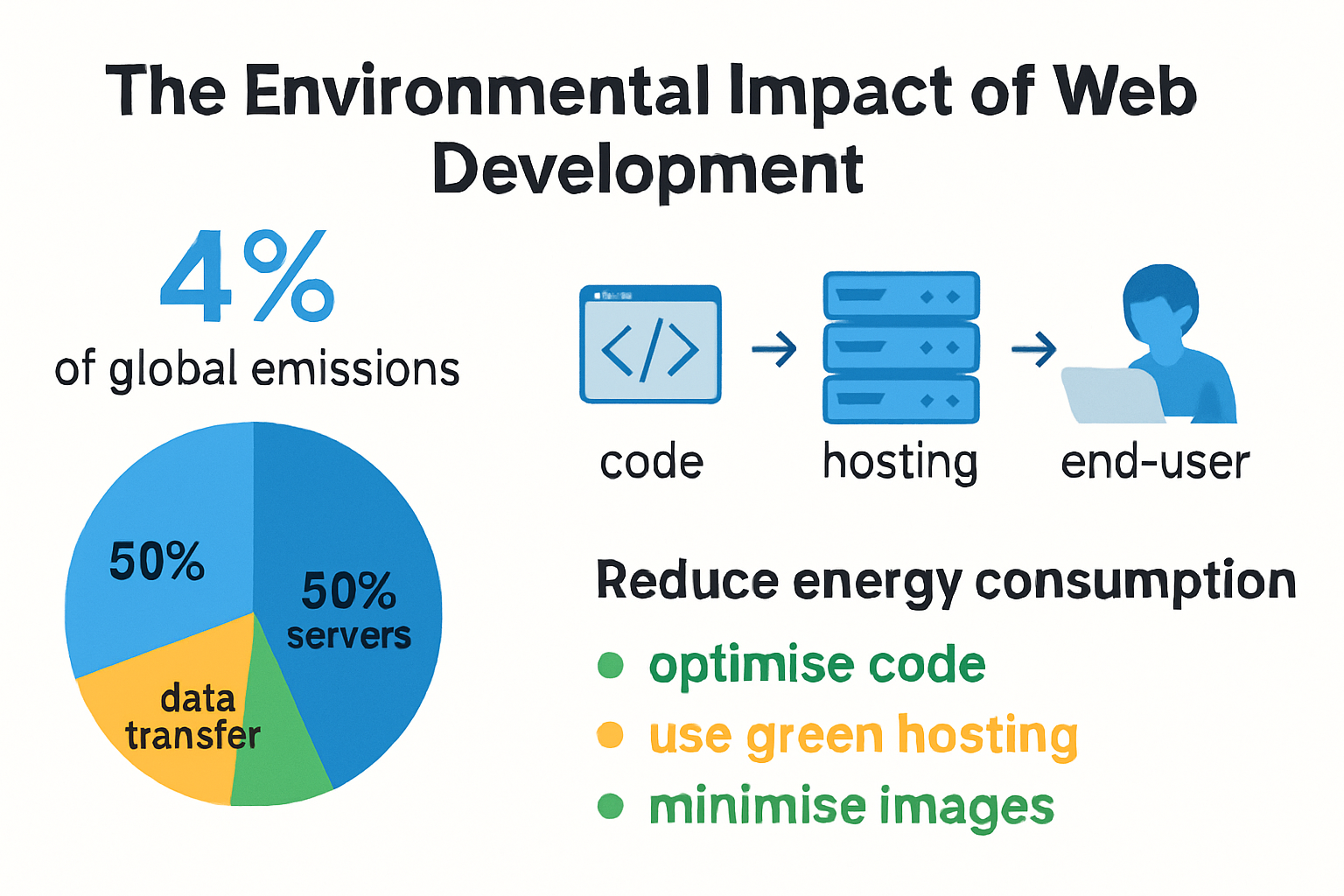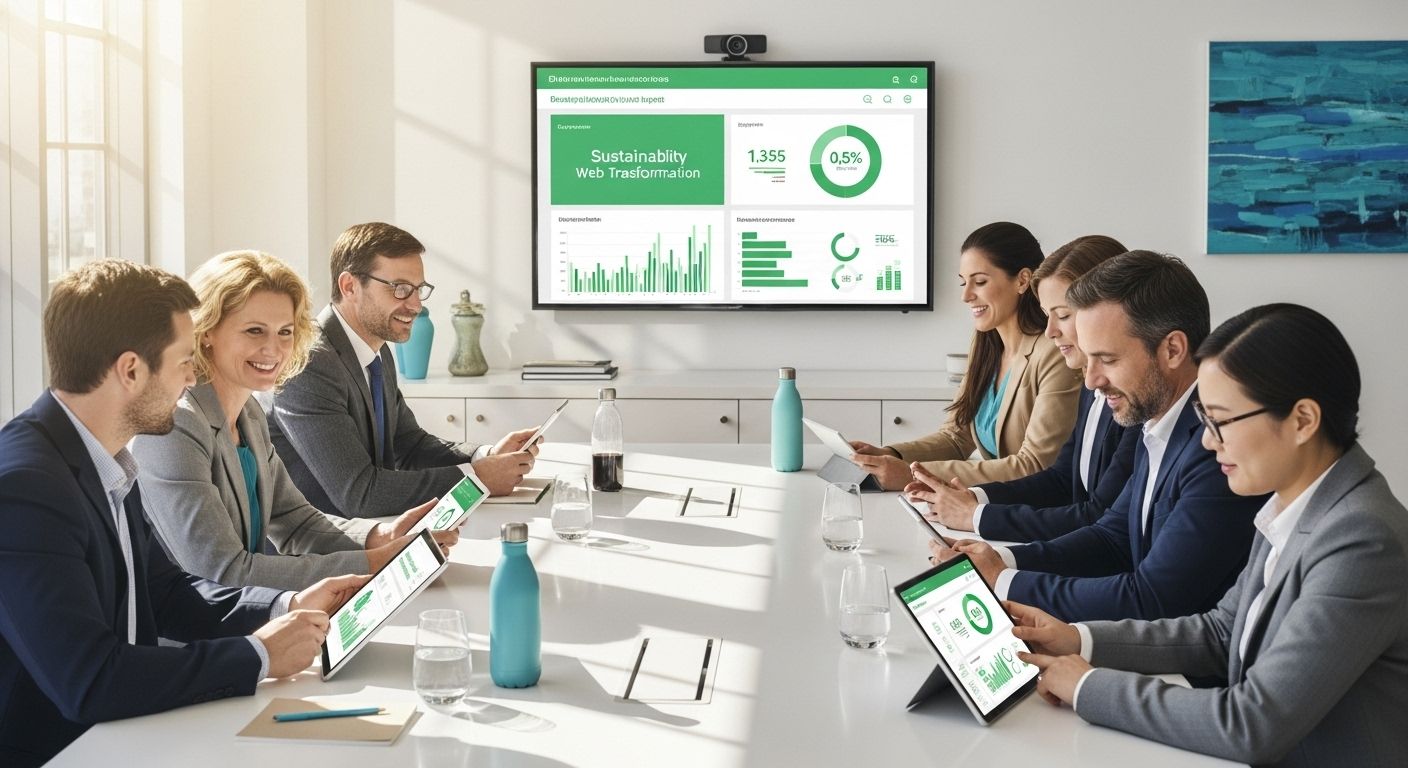Sustainable web development is turning heads as businesses scramble to cut costs and stand out online. It might shock you to know that digital technologies already produce 4 percent of global carbon emissions, and this number is set to double by 2025. Most people think web sustainability is all about saving the planet, but it is actually one of the smartest business strategies around, making companies faster, leaner, and way more competitive.
Table of Contents
- Understanding Sustainable Web Development Principles
- Key Benefits For Businesses And Organisations
- Practical Strategies For Building Green Websites
- Implementing Sustainable Practices At Scale
Quick Summary
| Takeaway | Explanation |
|---|---|
| Focus on code optimisation | Write lean, efficient code to enhance performance and reduce energy use. |
| Choose green hosting solutions | Select data centres powered by renewable energy to lower your carbon footprint. |
| Emphasise performance efficiency | Design websites that load quickly to improve user experience and energy consumption. |
| Implement ongoing monitoring | Regularly assess and optimise website performance to maintain sustainability standards. |
| Engage in cross-departmental collaboration | Foster teamwork across IT, design, and management for effective sustainable practice integration. |
Understanding Sustainable Web Development Principles
Sustainable web development represents a holistic approach to creating digital solutions that balance technological efficiency, environmental responsibility, and long-term business performance. It goes beyond traditional web development by considering the broader impact of digital infrastructure on resources, energy consumption, and overall ecological footprint.
The Environmental Impact of Digital Technologies
Modern web development has a significant environmental consequence that many businesses overlook. Research from the Shift Project reveals that digital technologies account for approximately 4% of global carbon emissions. This figure is projected to double by 2025, making sustainable web development not just an ethical choice but a critical business strategy.
The carbon footprint of web services stems from multiple sources:

To help clarify the main sources contributing to the carbon footprint of digital technologies, the following table summarises each source and its associated impact, as mentioned in the article:
| Source | Description |
|---|---|
| Server Energy Consumption | Data centres and cloud infrastructure require lots of electricity. |
| Data Transfer Efficiency | Unoptimised websites use more bandwidth and resources. |
| Hardware Lifecycle | Frequent upgrades lead to increased electronic waste. |
- Server Energy Consumption: Data centres and cloud infrastructure require massive amounts of electricity.
- Data Transfer Efficiency: Unoptimised websites consume more bandwidth and computational resources.
- Hardware Lifecycle: Constant technological upgrades contribute to electronic waste.
Core Principles of Sustainable Web Development
Sustainable web development integrates several key principles that minimise environmental impact while maintaining high-performance digital solutions. Sustainable Web Design Guidelines outline a comprehensive framework for developers and businesses.
Key strategies include:
- Code Optimisation: Writing lean, efficient code that reduces computational demands.
- Green Hosting Solutions: Selecting data centres powered by renewable energy.
- Performance Efficiency: Designing websites that load quickly and consume minimal resources.
- Minimalist Design: Reducing unnecessary graphical elements and complex animations.
Strategic Considerations for Businesses
Implementing sustainable web development is not just an environmental decision but a strategic business approach. Companies that prioritise digital sustainability gain competitive advantages through reduced operational costs, improved user experience, and enhanced brand reputation.
Businesses can start by exploring our comprehensive web development guide for practical insights into creating more sustainable digital solutions. By understanding and implementing these principles, organisations can create web platforms that are not only technologically advanced but also environmentally responsible.
The future of web development lies in recognising that technological progress and environmental stewardship are not mutually exclusive. Instead, they represent interconnected pathways towards more intelligent, efficient, and responsible digital ecosystems.
Key Benefits for Businesses and Organisations
Sustainable web development offers far-reaching advantages that extend well beyond environmental considerations. Modern businesses are discovering that strategic digital approaches can simultaneously drive operational efficiency, reduce costs, and create meaningful competitive advantages.
Performance and Economic Advantages
Businesses implementing sustainable web development strategies experience significant performance improvements. Research from Retail Insider indicates that organisations can reduce website operational costs by up to 30% through optimised code and efficient design practices.
Key performance benefits include:
Below is a summary table highlighting the key performance and economic advantages that businesses can gain by adopting sustainable web development practices:
| Advantage | Explanation |
|---|---|
| Reduced Energy Consumption | Uses less computational resources overall |
| Lower Hosting Expenses | Efficient code leads to reduced server costs |
| Faster Load Times | Minimalist design improves website speed and user experience |
- Reduced Energy Consumption: Streamlined websites consume less computational resources.
- Lower Hosting Expenses: Efficient code reduces server load and associated infrastructure costs.
- Faster Load Times: Minimalist design improves website speed and user experience.
Brand Reputation and Customer Engagement
Sustainable web development has become a powerful differentiator in the competitive digital marketplace. W3C Sustainable Web Guidelines highlight that eco-conscious consumers increasingly prefer businesses demonstrating environmental responsibility.
Customer perception benefits include:
- Enhanced Brand Image: Demonstrates commitment to environmental stewardship.
- Attracts Conscious Consumers: Appeals to environmentally aware market segments.
- Builds Corporate Credibility: Shows proactive approach to technological innovation.
Long-Term Strategic Benefits
Beyond immediate advantages, sustainable web development represents a strategic investment in future-proofing digital infrastructure. Learn more about how websites drive business success through intelligent design and sustainable practices.
Strategic advantages encompass:
- Scalable Infrastructure: Easier to adapt and modify sustainable web architectures.
- Technological Resilience: Better prepared for emerging digital transformation trends.
- Reduced Technical Debt: Clean, efficient code minimises long-term maintenance challenges.
Businesses that embrace sustainable web development are not merely reducing their environmental footprint. They are positioning themselves as forward-thinking, technologically sophisticated organisations capable of delivering exceptional digital experiences while maintaining robust economic and environmental responsibility.
The convergence of performance, reputation, and strategic innovation makes sustainable web development a critical consideration for any forward-looking business seeking to thrive in the digital ecosystem.
Practical Strategies for Building Green Websites
Creating environmentally responsible websites requires a strategic approach that integrates technological efficiency with ecological consciousness. Modern web development demands more than aesthetic considerations – it requires a comprehensive understanding of digital sustainability and practical implementation techniques.
Website Performance and Energy Efficiency
The Sustainable Web Design project emphasises that website performance directly correlates with energy consumption. Developers can significantly reduce digital carbon footprints by implementing targeted optimisation strategies.
Key performance optimization techniques include:
- Image Compression: Reducing file sizes without compromising visual quality.
- Efficient Code Writing: Minimising unnecessary scripts and computational demands.
- Lazy Loading: Loading content only when users scroll, reducing initial resource consumption.
- Caching Strategies: Implementing intelligent caching to reduce repeated data transfers.
Green Hosting and Infrastructure Choices
Selecting the right hosting infrastructure plays a crucial role in sustainable web development. User Experience Best Practices highlight that green hosting solutions can dramatically reduce a website’s environmental impact.
Critical considerations for green hosting include:
- Renewable Energy Powered Data Centres: Choosing providers using solar, wind, or hydro energy.
- Carbon Offset Programmes: Selecting hosts with verified environmental compensation strategies.
- Energy-Efficient Server Hardware: Prioritising modern, low-energy computational infrastructure.
- Geographical Server Proximity: Reducing data transmission distances to minimize energy consumption.
Monitoring and Continuous Improvement
Sustainable web development is an ongoing process of measurement, analysis, and refinement. Businesses must adopt a proactive approach to understanding and minimising their digital environmental footprint.
Recommended monitoring practices include:
- Carbon Emission Calculators: Regularly assessing website energy consumption.
- Performance Auditing Tools: Identifying and addressing inefficient code or design elements.
- Regular Website Optimization: Continuously updating and streamlining digital platforms.
- Transparent Reporting: Communicating sustainability efforts to stakeholders and customers.
By integrating these strategies, businesses can create websites that are not just visually appealing and functionally robust, but also environmentally responsible. The future of web development lies in recognising that technological innovation and ecological sustainability are complementary, not competing, objectives.
Every digital choice represents an opportunity to reduce environmental impact while delivering exceptional user experiences. Green web development is no longer an optional approach – it is becoming a fundamental expectation for forward-thinking organisations.
Implementing Sustainable Practices at Scale
Implementing sustainable web development practices across entire organisational ecosystems requires a comprehensive, strategic approach that goes beyond individual project considerations. Businesses must develop robust frameworks that integrate environmental consciousness into their core technological infrastructure and development methodologies.
Organisational Strategy and Governance
Systematic research from academic literature reveals that successful large-scale sustainable web development implementation demands structured governance models. Organisations need clear guidelines, measurement protocols, and accountability mechanisms to effectively transform their digital infrastructure.
Key strategic components include:
- Cross-Departmental Collaboration: Integrating sustainability goals across IT, design, and management teams.
- Standardised Assessment Frameworks: Developing consistent metrics for measuring digital environmental impact.
- Training and Skill Development: Upskilling teams in sustainable web development principles.
- Regular Performance Auditing: Implementing continuous monitoring and improvement processes.
Technical Implementation and Tooling
Web Sustainability Guidelines provide comprehensive frameworks for technical implementation. Businesses must invest in sophisticated tools and methodologies that enable systematic reduction of digital carbon footprints.
Practical implementation strategies involve:
- Automated Carbon Tracking Tools: Integrating real-time emissions monitoring into development workflows.
- Green Technology Stacks: Selecting programming languages and frameworks with lower computational overhead.
- Modular and Efficient Architecture: Designing scalable systems that prioritise resource efficiency.
- Containerisation and Cloud Optimization: Leveraging modern infrastructure that supports dynamic resource allocation.
Enterprise-Level Transformation
Research from industry experts highlights that sustainable web development is more than a technical challenge – it represents a holistic business transformation.
Comprehensive transformation strategies include:
- Cultural Change Management: Embedding sustainability as a core organisational value.
- Regulatory Compliance Preparation: Anticipating and exceeding emerging environmental technology regulations.
- Competitive Differentiation: Positioning sustainability as a strategic business advantage.
- Long-Term Investment Planning: Developing roadmaps for continuous technological evolution.
Successful implementation of sustainable web development at scale requires more than technological solutions. It demands a fundamental reimagining of how businesses approach digital infrastructure, viewing environmental responsibility not as a constraint, but as an opportunity for innovation and strategic differentiation.
Organisations that embrace this approach will not only reduce their environmental impact but also create more efficient, resilient, and forward-thinking digital ecosystems that are prepared for the challenges of future technological landscapes.

Frequently Asked Questions
What is sustainable web development?
Sustainable web development is a holistic approach to creating digital solutions that balance technological efficiency with environmental responsibility, aiming to minimize carbon emissions while enhancing business performance.
How does web development contribute to carbon emissions?
Digital technologies account for approximately 4% of global carbon emissions, primarily due to server energy consumption, data transfer inefficiencies, and the lifecycle of hardware that leads to electronic waste.
What are the benefits of adopting sustainable web development practices for businesses?
Businesses that adopt sustainable web development can experience significant performance improvements, reduce operational costs by up to 30%, enhance brand reputation, and appeal to environmentally conscious consumers.
What practical strategies can businesses implement for sustainable web development?
Key strategies include optimising code for efficiency, selecting green hosting solutions powered by renewable energy, implementing lazy loading for content, and continuously monitoring website performance to ensure sustainability standards are met.
Take the Lead with Sustainable Web Solutions for Your Business
Feeling frustrated by high website costs, slow performance, or growing pressure to go green? Your organisation deserves digital solutions that work smarter and leave a lighter footprint. With global carbon emissions from digital operations rising rapidly, making your business website more sustainable has never felt more urgent. Yet, building lean, high-performing websites that reflect your brand’s commitment can be tricky when you are juggling budgets, performance goals, and customer expectations.
At Cloudfusion, we specialise in creating custom, future-ready websites tailored for South African businesses that want a competitive edge through sustainability. We apply the best practices in code optimisation, performance efficiency, and green hosting, just as explained in our comprehensive approach. We help you reduce operational costs, sharpen your digital reputation, and build resilient infrastructure for long-term growth. Contemplating sustainable development? See how our web design and development quotation service can transform your online presence. Don’t fall behind in the race towards digital efficiency. Start your journey to a greener, faster, and more future-proof website today.








